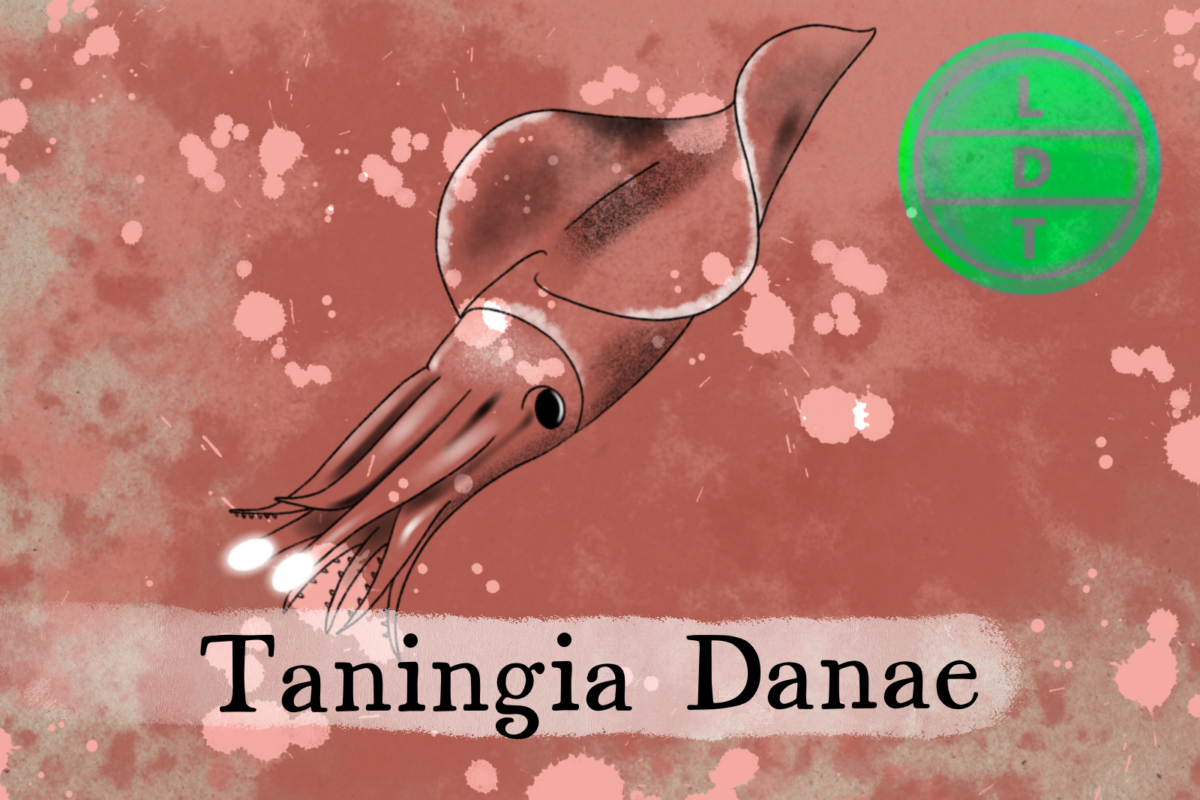“…and today we’re talking about a rising star in the sea. But more on that later.”
Imagine you’re swimming a casual 4000 feet below the waves in the inky blackness of the bathypelagic zone when you come across a pair of what seems like headlights. Is it a car? Is it a plane? No, it’s a squid with its brights on. The Dana Octopus Squid is a shiny fellow and isn’t afraid to let that light shine before men that they may see his squid deeds. But when you live where the sun doesn’t shine, you’ll need a light to survive here in Life, Death, and Taxonomy.
Description of the Dana Squid
The body coloration is not well-documented, but they are likely to have a deep-sea adapted coloration which is generally darker to blend in with the deep ocean.
Their arms are equipped with hooks, almost like cat claws, on their suckers, which they use to grasp prey.
Because of their deep-sea habitat, sightings and detailed descriptions of their appearance are rare. Most of our knowledge comes from specimens that have been washed ashore or captured during deep-sea expeditions
Measure Up
Total Length
2.3 m (7.5 ft)
A dana squid is the same length as…
- 654 fingernails, stacked
- One Peter Mayhew
- One 309,000th the length of Tennessee
Fact: Peter Mayhew, the actor that plays Chewbacca, is 7’2”
Weight
161.4 kg (356 lb)
The dana squid is the same as…
- A Honda Golden Wing Touring motorcycle
- One 7th the largest pig
- 15 six-month-old boxer puppies
Fact: The heaviest pig ever recorded was Big Bill, a Poland China hog from Tennessee. Big Bill weighed an astonishing 2,552 pounds (1,158 kilograms) and was recognized by the Guinness World Records for his size.
Fast Facts about the Dana Squid
The Dana octopus squid is an ocean creature which means it lives everywhere.
Bioluminescence: This species possesses large photophores, which are light-producing organs. They can use these to emit blinding flashes, possibly to disorient prey or communicate².
Habitat: Danas is found in oceans worldwide and is believed to live at depths down to 3,000 feet.
Diet: It is a top predator in its environment¹.
Conservation Status: Currently, Taningia danae is listed as Least Concern by the IUCN, indicating that it is not at immediate risk of population decline¹.
These creatures are still shrouded in mystery, and much of what we know comes from specimens that have been washed ashore or captured in deep-sea research expeditions. Their elusive nature continues to intrigue scientists and ocean enthusiasts alike.
Major Fact: Someone’s In the Kitchen With Dana
The Dana Octopus Squid, also known as Taningia danae, possesses unique photophores distributed across its body.
Photophores are specialized light-producing organs found in many deep-sea organisms, aiding in communication, camouflage, and hunting.
These photophores are particularly prominent in the Dana Octopus Squid, located mainly along its arms and mantle.
But the most obvious photophores are on its two stubby little arms. Most photophores are a few fractions of an inch long. They are the size of lemons and have a black eyelid thing that can open and close. If you’ve ever fought a resident evil boss, you’ve probably shot something like this. These are the largest photophores in the animal kingdom.
The photophores emit a blue-green bioluminescent light, which the squid can control both in intensity and duration.
Researchers believe that the squid uses its photophores for communication, attracting mates, and possibly confusing or deterring predators.
The arrangement of photophores on the Dana Octopus Squid’s body is thought to be species-specific, aiding in identification and mate recognition.
When startled, the squid often flashes these lights quickly apparently in an effort to quickly blind predators and escape or to blind prey and close in. Though researchers still aren’t sure since observing these squids is so difficult and most of what we know about them comes from the stomach contents of sperm whales hunted in the 70s.
Ending: So get down to a cozy depth, turn on your brights, and blind your foes like the dana octopus squid here in LDT.

